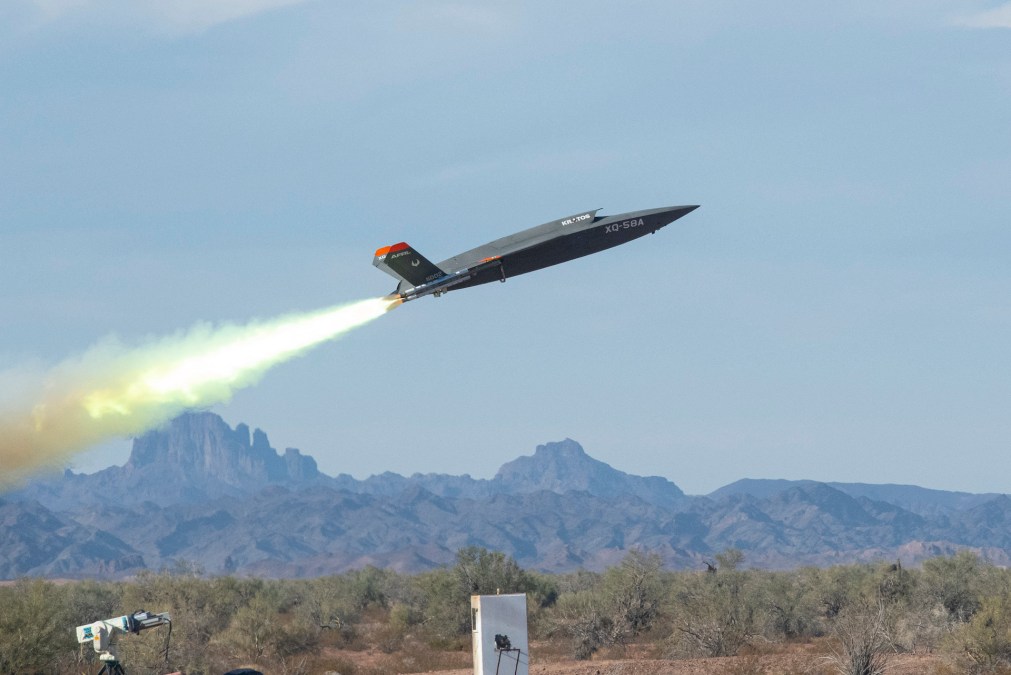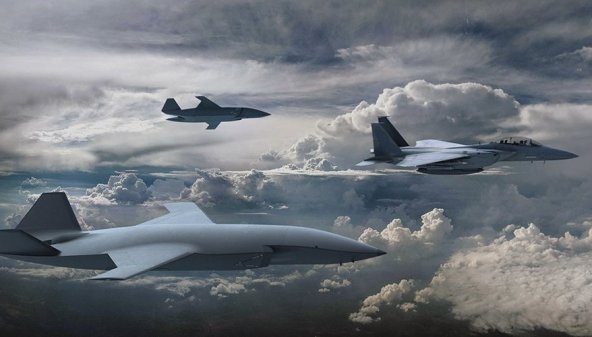‘Live, live, die’ — How the Air Force plans to authorize robotic wingmen to attack targets

The Air Force is still fleshing out what the pilot-vehicle interface will look like for the robotic wingmen it’s pursuing. But a human will have to give the green light before drones can launch weapons, according to officials involved in the pursuit of new “collaborative combat aircraft.”
The future unmanned aerial systems — a top priority of Air Force Secretary Frank Kendall — are expected to be more autonomous than today’s drones and operate as part of a team with manned fighter jets and other aircraft.
However, the initial iteration of these types of platforms won’t function like an airborne “Terminator,” Maj. Gen. R. Scott Jobe, director of plans, programs and requirements at Air Combat Command, told reporters during a media roundtable at the Pentagon on Thursday.
“For the warfighting requirements, we did not swing for the fences — we went for a base hit. So, I’m not talking about Terminator … [level of] autonomy,” he said.
The Air Force is still pondering what the pilot-vehicle interface (PVI) will be for the airmen overseeing the collaborative combat aircraft (CCA), but “a whole lot of work” will be done in that regard in 2023, he noted.
The PVI probably won’t be a “hands-on” stick or throttle. However, airmen could send commands to the drones using something like a tablet or buttons, officials say.
“We’re still exploring all those technologies. But we see it more along the lines of, I’m going to be able to issue some behavioral commands and do some mission planning — a combination of those two — until I get to the point where I need to lethally or non-lethally engage with an effect. That’s going to be a human on the loop for the foreseeable future. We just don’t see a path right now for us to field a [fully autonomous drone] capability that both is effective in this warfighting capacity, but also supports American values and the law of armed conflict,” Jobe said.
“I’m not going to have this robot go out and just start shooting at things [on its own]. That’s not something we’re going to do. So, there’ll be a human in or on the loop in that way for sure to be able to target a particular track, communicate with the CCA vehicle and then have it engage. Just think of it as just an extension of your weapons bay if you’re in an F-22, F-35 [pilot] or whatnot,” he added.
Brig. Gen. Joseph Kunkel, director of plans and deputy chief of staff for plans and programs at Air Force headquarters, said: “There will be a person that consents to weapons coming off an airplane … if there’s going to be lethal effects employed.”
He envisions an operational scenario where an airman could issue orders to a CCA along the lines of “live, live, die” — to tell the drone which potential targets it should destroy or not engage.
Jobe noted that an airman might also have to give the green light before a CCA could employ certain “non-kinetic” tools — not just missiles.
In military parlance, the term “non-kinetic” is often applied to things like electronic warfare or cyberattacks.
“You could easily see some non-kinetic effectors being just as bad if things go wrong than a kinetic effect [with missiles or other weapons]. But I think our initial thoughts … are it’s probably some sort of designation on a screen or a button or something in a cockpit with a person flying in the vicinity of one of these [making those decisions to launch an attack] — at least early on,” he said.
However, officials do want the drones to be able to perform a variety of other functions autonomously. That includes actions like take-off and landing, flying in formation, station keeping and routing.
Air Force officials have been laying the groundwork for a future CCA program of record. That includes science-and-technology initiatives like the Air Force Research Lab’s Skyborg program; modeling and simulation; identifying requirements; and developing tactics, techniques and procedures, among other efforts.
The service has been engaging with contractors as it explores the drone technology, including testing autonomy capabilities with contractor-provided UAS.
“What we’ve already been able to identify with our engagements with industry and looking at our analytics is kind of the broad requirements, attributes of air vehicles, what we need with communications capabilities, and what different missions we could do with what type of sensors and weaponry,” Jobe said.
The requirements work has involved looking at speed, range, endurance, sustained turn rates and autonomy behaviors, he noted.
“We’re doing the follow-on work right now of exploring, OK, how do we train our airmen to do [teaming with the CCAs]? What would an organizational structure look like? What would a squadron of the future of these things look like? … We just started all of that. But we’re moving pretty fast in the requirements pieces and the concepts of operations,” he said.
The Pentagon is putting together its 2024 program objective memorandum, and the next DOD budget request is expected to be delivered to Congress in the spring.
“We’re not gonna get ahead of the ‘24 budget. But what I can say is, when our budget goes across the river, you’re going to see a significant investment in this [CCA initiative]. And the secretary’s guidance to me was: Resource this so we can field the capability as soon as possible. So, you’ll see a significant investment not only in the program but also in some risk-reduction efforts as well to help us field an operational capability as soon as possible,” Kunkel said.
Officials at the roundtable declined to say how long it would take to field the drones once a formal program of record is launched. However, senior service officials have said they hope to have them ready in time for the rollout of the manned Next-Generation Air Dominance (NGAD) stealth fighter that the drones will be teamed with. Secretary Kendall has said he hopes the NGAD will have operational capability by 2030.
The service plans to hold an industry competition for the CCA program with multiple vendors involved in the development phase for as long as possible, according to Brig. Gen. Dale White, program executive officer for fighters and advanced aircraft.
“I think we’ll probably once the competition phase is done, we’ll have a singular vehicle,” Jobe told reporters. “Later on, though, I think we’ll see missions expand, I think we’ll see capability development continue, I think we’ll probably see different vehicles” procured at some point.
The Air Force hopes to field the first iteration of robotic wingmen as soon as possible to maintain an edge over China. However, the service aims to grow CCA capabilities over time, White noted.
“We’re also looking at what’s next and what’s the art of the possible,” Maj. Gen. Heather Pringle, commander of the Air Force Research Lab, told reporters. The service wants to “keep the science-and-technology pipeline running and just keep going and keep looking for the next level of autonomy and the next and the next and the next.”






